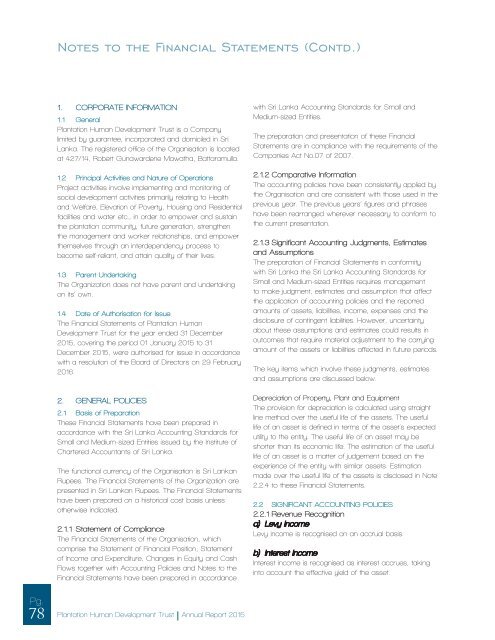PHDT Annual Report 2015
Create successful ePaper yourself
Turn your PDF publications into a flip-book with our unique Google optimized e-Paper software.
Notes to the Financial Statements (Contd.)<br />
1. CORPORATE INFORMATION<br />
1.1 General<br />
Plantation Human Development Trust is a Company<br />
limited by guarantee, incorporated and domiciled in Sri<br />
Lanka. The registered office of the Organisation is located<br />
at 427/14, Robert Gunawardene Mawatha, Battaramulla.<br />
1.2 Principal Activities and Nature of Operations<br />
Project activities involve implementing and monitoring of<br />
social development activities primarily relating to Health<br />
and Welfare, Elevation of Poverty, Housing and Residential<br />
facilities and water etc., in order to empower and sustain<br />
the plantation community, future generation, strengthen<br />
the management and worker relationships, and empower<br />
themselves through an interdependency process to<br />
become self-reliant, and attain quality of their lives.<br />
1.3 Parent Undertaking<br />
The Organization does not have parent and undertaking<br />
on its’ own.<br />
1.4 Date of Authorisation for Issue<br />
The Financial Statements of Plantation Human<br />
Development Trust for the year ended 31 December<br />
<strong>2015</strong>, covering the period 01 January <strong>2015</strong> to 31<br />
December <strong>2015</strong>, were authorised for issue in accordance<br />
with a resolution of the Board of Directors on 29 February<br />
2016.<br />
2. GENERAL POLICIES<br />
2.1 Basis of Preparation<br />
These Financial Statements have been prepared in<br />
accordance with the Sri Lanka Accounting Standards for<br />
Small and Medium-sized Entities issued by the Institute of<br />
Chartered Accountants of Sri Lanka.<br />
The functional currency of the Organisation is Sri Lankan<br />
Rupees. The Financial Statements of the Organization are<br />
presented in Sri Lankan Rupees. The Financial Statements<br />
have been prepared on a historical cost basis unless<br />
otherwise indicated.<br />
2.1.1 Statement of Compliance<br />
The Financial Statements of the Organisation, which<br />
comprise the Statement of Financial Position, Statement<br />
of Income and Expenditure, Changes in Equity and Cash<br />
Flows together with Accounting Policies and Notes to the<br />
Financial Statements have been prepared in accordance<br />
with Sri Lanka Accounting Standards for Small and<br />
Medium-sized Entities.<br />
The preparation and presentation of these Financial<br />
Statements are in compliance with the requirements of the<br />
Companies Act No.07 of 2007.<br />
2.1.2 Comparative Information<br />
The accounting policies have been consistently applied by<br />
the Organisation and are consistent with those used in the<br />
previous year. The previous years’ figures and phrases<br />
have been rearranged wherever necessary to conform to<br />
the current presentation.<br />
2.1.3 Significant Accounting Judgments, Estimates<br />
and Assumptions<br />
The preparation of Financial Statements in conformity<br />
with Sri Lanka the Sri Lanka Accounting Standards for<br />
Small and Medium-sized Entities requires management<br />
to make judgment, estimates and assumption that affect<br />
the application of accounting policies and the reported<br />
amounts of assets, liabilities, income, expenses and the<br />
disclosure of contingent liabilities. However, uncertainty<br />
about these assumptions and estimates could results in<br />
outcomes that require material adjustment to the carrying<br />
amount of the assets or liabilities affected in future periods.<br />
The key items which involve these judgments, estimates<br />
and assumptions are discussed below.<br />
Depreciation of Property, Plant and Equipment<br />
The provision for depreciation is calculated using straight<br />
line method over the useful life of the assets. The useful<br />
life of an asset is defined in terms of the asset’s expected<br />
utility to the entity. The useful life of an asset may be<br />
shorter than its economic life. The estimation of the useful<br />
life of an asset is a matter of judgement based on the<br />
experience of the entity with similar assets. Estimation<br />
made over the useful life of the assets is disclosed in Note<br />
2.2.4 to these Financial Statements.<br />
2.2 SIGNIFICANT ACCOUNTING POLICIES<br />
2.2.1 Revenue Recognition<br />
a) Levy Income<br />
Levy income is recognised on an accrual basis.<br />
b) Interest Income<br />
Interest income is recognised as interest accrues, taking<br />
into account the effective yield of the asset.<br />
Pg.<br />
78 Plantation Human Development Trust <strong>Annual</strong> <strong>Report</strong> <strong>2015</strong>


